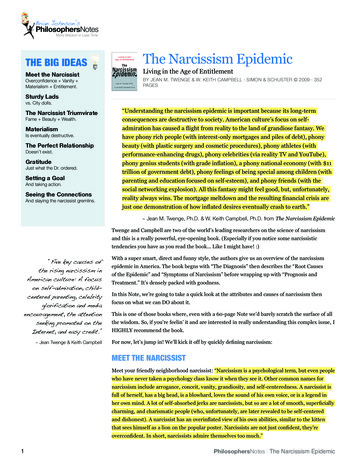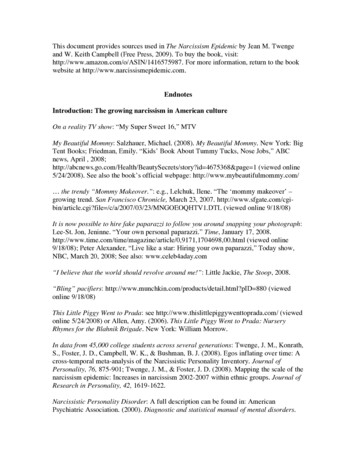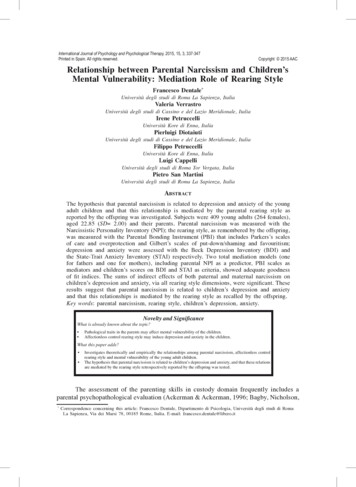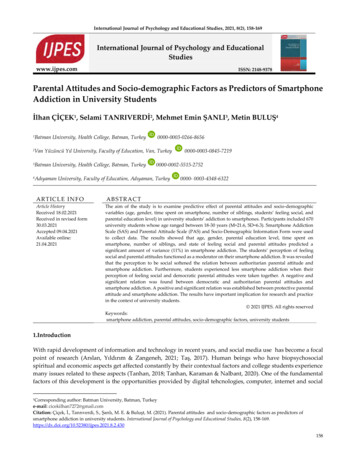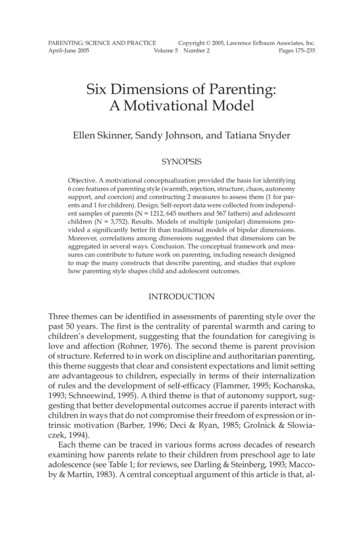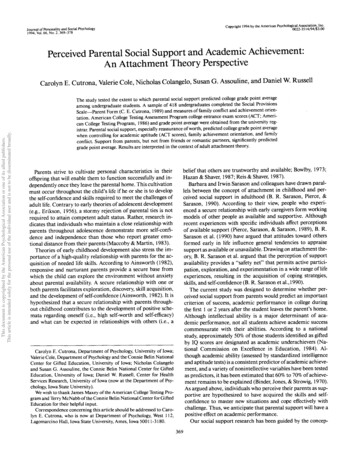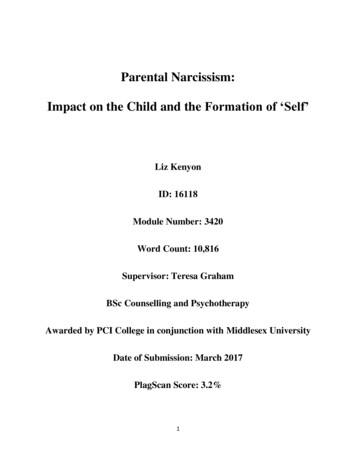
Transcription
Parental Narcissism:Impact on the Child and the Formation of ‘Self’Liz KenyonID: 16118Module Number: 3420Word Count: 10,816Supervisor: Teresa GrahamBSc Counselling and PsychotherapyAwarded by PCI College in conjunction with Middlesex UniversityDate of Submission: March 2017PlagScan Score: 3.2%1
Table of pter 1: The Narcissistically Afflicted Parent10Definition of Narcissism10The Mother14The Family16Chapter 2: The Narcissistically Injured Child19Attachment20Identity Formation23Differentiation2729Chapter 3: The Road to RecoveryAdult Experience29Therapeutic nces422
AcknowledgementsTo Niall, Alice and Lara,Thank you for all your love, support, patience and understanding.Without which I could not have embarked on this project.You kept me going.To my dear friend Linda,Thank you for all your help and encouragement.I am so grateful to have had a friend on this journey with me.You kept me sane.To my mother,Thank you for your all love; you have been an inspiration.Without which I could not have deepened my understandingor nurtured my compassion.3
AbstractThe primary purpose of this proposition essay is to consider the nature of narcissism and itsvarying faces of expression, ranging from the healthy, to the sub-clinical, to the pathological.Due to the breadth of the subject matter, the lens of focus has been narrowed to concentrate onthe experience of parental narcissism and the detrimental impact this has upon a child’s naturaldevelopment process and ability to form a cohesive self-concept.In order to adequately outline, explore and validate the subject matter, the essay has beenstructured and developed by focusing on three key areas: the narcissistically afflicted parent andan analysis of how this dysfunctional behaviour is expressed, the narcissistically afflicted childand an analysis of how this dysfunctional behaviour is received, and the road to recovery and ananalysis of how this dysfunctional behaviour might be understood, processed and reframed.The first chapter considers what it means to be narcissistic, firstly by referencing a healthyexpression, or how one might achieve a secure sense of self, and then by considering what itmeans to have a full blow personality disorder in accordance with the DSM-V criteria. Parentalnarcissism is then viewed from two angles in the form of overtly narcissistic parenting, which isobvious in expression and oblivious in reaction to others, and covertly narcissistic parenting,which is subtle in expression and hypervigilant in reaction to others. The chapter outlines howboth expressions exhibit non-nurturing, non-validating and neglectful parenting behaviourtowards the child.The second chapter takes the position of the child and considers what it means to be on thereceiving end of narcissistic parenting and in particular how it affects the nurturing of anattachment bond, the formation of an identity and the emancipation of a personality. The findings4
show that the parent’s lack of emotional availability, their unwillingness to tolerate willfulbehaviour and their non-acceptance of autonomous expression and personality, lead to theformation of an insecurely-ambivalent attachment style, a shame-based identify and anundifferentiated personality within the child.The third chapter reflects on how these early childhood injuries continue to shape and influencethe adult’s experience, with particular reference to the development of codependence and toxicshame. Psychotherapy is then considered as a means by which one might heal the woundsinflicted and nurture a recovery process. By combining intellectual understanding with emotionalprocessing and cognitive reframing, the findings show how a person can shed their protectiveself-image and reconnect with their core self.The proposition paper concludes with a set of recommendations in order to facilitate recoveryand emotional growth for the client and expand knowledge and awareness for the therapist. Theprinciple intention of providing these suggestions is to enable the client to build upon thefoundation work already achieved during the psychotherapy process and to educate the therapistand widen their perspective in order that they may facilitate this process more effectively andmeet the ethical standards required by their profession.5
IntroductionThe recognition and understanding of narcissism as an expression of human behaviour is as oldas the Greek legend from which it heralds and has been portrayed through art and literature eversince (Ronningstam, 2005). Yet our fascination with its cause and affect has taken on a newdimension in recent times and the word ‘narcissist’ has become “a public word in commonparlance” (Shaw, 2014, p.1). This liberty of expression does not however adequately reflect thecomplexity of the subject matter; it is not possible to apply a ‘one size fits all’ approach to eitherthe characteristics of the afflicted or the grievances of the injured. As a spectrum disorder,narcissism has a huge range of expression, extending from a healthy form at one end, which weall aspire to achieve (Horwitz, 2000, as cited in MacDonald, 2014), to the sub-clinicalmanifestation of a few narcissistic traits such as solipsism (Lowen, 1985), to an insidious butcovert form demonstrated within the family system (Donaldson-Pressman, Pressman, 1994),finishing at the far end of the spectrum with a full-blown pathological syndrome in the form ofNarcissistic Personality Disorder (NPD) (Louis De Canonville, 2015). We could even take onestep beyond NPD into the fascinating but frightening world of the malignant psychopath anddescribe a person who is the ultimate “face of evil” (Louis De Canonville, 2015, p.1).According to Twenge and Campbell (2009), there has been a phenomenal rise in the incidence ofnarcissism within our culture over the last 20 years, particularly in America. In data collectedfrom 37,000 American college students in 2006 for example, 1 out of 4 participants answeredpositively to the majority of questions listed on the standardized Narcissistic PersonalityInventory (NPI). The authors also estimate that a total of 5% of all American 20 year oldsactually have the pathological form of narcissism, NPD (Twenge & Campbell, 2009). With everincreasing levels of greed, self-obsession, arrogance and vanity, more and more people are being6
“seduced by the increasing emphasis on material wealth, physical appearance, celebrity worshipand attention seeking” (Twenge & Campbell, 2009, p.2). This shift in cultural values needs to beconsidered in our understanding of narcissism as a whole because as Alexander Lowen explains“narcissism of the individual parallels that of the culture; we shape our culture according to ourimage and in turn we are shaped by that culture” (Lowen, 1985, p.5).Since most of the literature to date has focused specifically on the nature of the ‘narcissist’ andthe personality traits exhibited by its offenders, it has been decided that this proposition paperwill concentrate on the experience of the victim instead, especially since these people are morelikely than their abusers to seek out therapy in an attempt to understand and heal their wounds.The main contention of this paper is that the effects of narcissistic injury, particularly from aparent, leave a devastating and toxic impression on the emotional lives of all those childrenunfortunate enough to encounter them; if for example, a child continually prioritizes the needsand expectations of their parents, at the sacrifice of their own feelings and judgements, then theymay sabotage their self-concept and ability to live a real and authentic life (Miller, 2007).In order to adequately explain the nature of narcissism and its injurious effects on others, it isnecessary to narrow our lens somewhat and focus on some specific areas. As a result, theproposition will concentrate on two key modes of the expression: a pathological type in the formof an overtly narcissistic mother and her impact on a daughter, and a subclinical type in the formof a covertly narcissistic family system and its impact on the children. The mother-daughterrelationship is of interest for 3 main reasons: firstly narcissism tends to be associated more withmen than women with a 50-75% ratio recorded in the DSM-V (2013). According to the literaturehowever, female narcissism is still very much in existence but more difficult to recognizebecause its expression is more stealth like and hidden due to the cultural norms and expectations7
placed on female behaviour. Secondly, whilst sons also suffer at the hands of a maternalnarcissist, for a daughter, a mother represents her “primary role model for developing as anindividual, lover, wife, mother and friend, and aspects of maternal narcissism tend to damagedaughters in particularly insidious ways” (McBride, 2008, p.6). Thirdly, since women arecurrently inclined to seek out therapy more than men, it is the daughters of maternal narcissiststhat a therapist is more likely to encounter in the therapy room. In choosing to look at a covertlynarcissistic family system, the intention is to highlight how a situation that is less easilyidentifiable and does not merit a clinical diagnosis is destructive to its victims nonetheless. Tothe outside world, this type of family looks absolutely fine but if the needs of the parentscontinuously take precedence over the needs of the children, then the damage is done, and theseadult children struggle with their sense of self but fail to understand why (Donaldson-Pressman,Pressman, 1994).To answer the proposition, why parental narcissism is so injurious to children and detrimental tothe formation of a strong sense of self, the essay will be shaped in the following way:Chapter 1 will focus on the narcissistically afflicted parent; it will begin by defining whatnarcissism is by briefly considering its classical and psychoanalytical origins before outlining ourmodern-day interpretation of the condition. It will then be considered what it means to havehealthy narcissism and a strong sense of self in order to establish a yardstick for understandingdysfunctional narcissism. Next, the chapter will look in more detail at the behaviours of our twokey players: an overtly narcissistic mother, which will be based on the model provided by KarylMcBride (2008) and a covertly narcissistic family system, based on the model provided byStephanie Donaldson-Pressman and Robert Pressman (1994).8
Chapter 2 will focus on the narcissistically injured child; it will outline how parental narcissisminterferes with the normal growth and development of a child by referring to John Bowlby’swork on attachment styles and behaviours, Erik Erickson’s explanation of the psychosociallifespan phases and identity formation and finally Murray Bowen’s work on differentiation andthe individuation process. Each development process will be considered from a healthystandpoint and then also in relation to the overt and covert expressions of parental narcissismused throughout this essay.Chapter 3 will focus on recovery from narcissistic injury and how psychotherapy can help to healemotional wounds; it will begin by outlining the adult experience and the ways in which theinitial childhood injury becomes shaped and expressed in later life. The concepts ofcodependence and toxic shame will be considered alongside the personality characteristicstypically displayed by daughters of overtly narcissistic mothers and children of covertlynarcissistic families. Psychotherapy as a recovery tool will then be examined by referencing arange of techniques and perspectives to show how one might heal one’s wounds and reconnect tothe self. Finally a number of recommendations will be proposed as a means by which both clientand counsellor might work to reinforce and expand their understanding of, and recovery from,the impact of parental narcissism.9
Chapter 1: The Narcissistically Afflicted ParentDefinition of NarcissismClassical OriginsThe origin of the word ‘narcissism’ has its roots in classical art and literature which stretch backover a thousand years. Beginning with the mythological Greek legend by Ovid, the story ofNarcissus has been portrayed on canvas and paper many times since. Ranging from theRenaissance painting by Caravaggio, to Charles Dickens’ Miss Haversham in Great Expectationsor Oscar Wilde’s, The Picture of Dorian Gray, these works have used the image of Narcissus tohelp “illustrate the dangerous sinfulness and deadly punishment attached to excessive selfpreoccupation and self-adulation” (Ronningstam, 2005, p.3).In the original poem by Ovid, Narcissus is portrayed as a beautiful but proud young thespianwho was so preoccupied with his own beauty that he was unable “to see, hear or react to theneeds of another” (Donaldson-Pressman, Pressman, 1994, p.11). In the story, the river nymphEcho falls in love with Narcissus and tries desperately to gain his attention. Sadly, Narcissus isso enthralled with his own beauty that he scorns the mournful cries of Echo and she dies of abroken heart. To punish him for the crime of unrequited love, the Greek Gods seduce Narcissusto fall in love with his own reflection, which he attempts to touch but fails to embrace, untileventually he too fades away and dies (Golomb, 1992).Psychoanalytic OriginsThe mythological characters of Narcissus and Echo have come to represent the concept ofdestructive self-love; a concept which, at the turn of the 20th Century, was transitioned out of10
mythology and incorporated into psychology through the work of Sigmund Freud and his peers.In his essay ‘On Narcissism: An Introduction’ in 1914 (Freud, Strachey & Tyson, 2001) Freudused an instinctual drive theory to explain how narcissism develops. He differentiated between ahealthy or primary form of narcissism (which occurs in us all) to an unhealthy or secondarynarcissism (which occurs when things go amiss). The former type describes how infants initiallyinvest their libidinal energy into their egos but that the imbalance caused creates a conflict for thechild and prompts him to transfer some of the libido onto an external object instead, such as themother (Storr, 1989). When this occurs, then appropriate attachments can result. Freud believedthat this division of libido investment is a normal and healthy human expression since we areequally driven to facilitate the building of self-esteem as well as mutually supportive adultrelationships (Snowden, 2006). If however this process is impeded in some way, e.g. due to theinjury caused by either an overly-indulgent or overly-neglectful parent, then Freud’s second typeof narcissism will occur. When this happens, the child withdraws their libidinal energy awayfrom the external objects and reinvests it into the ego instead. Freud’s work on narcissism isconsidered to be the first major psychological contribution to our understanding of the subjectmatter, however it was the later works of the psychoanalysts, Otto Kernberg and Heinz Kohutwho actually conceptualized his Narcissus metaphor into the pathological disorder that weunderstand today (Donaldson-Pressman, Pressman, 1994).Modern-Day PerspectiveHaving briefly considered the classical and psychological origins of narcissism, let us now directour attention to a more modern day perspective of the condition by referring to the informationprovided in the Diagnostic and Statistical Manual of Mental Disorders (DSM-V, 2013).According to the DSM, Narcissism is described as a spectrum disorder which operates on a11
continuum ranging from the sub-clinical at one end (with just a few traits) to the pathological atthe other (with a full-blown personality disorder). Some of the characteristics listed to describean individual with narcissism include the following: “a person with a grandiose sense of selfimportance, a preoccupation with fantasies of unlimited success and power, a belief that he orshe is special and unique, a need for excessive admiration, a sense of entitlement, isinterpersonally exploitative, envious, jealous and arrogant and lacks empathy for others” (DSMV, 2013, p.669). As with most mental disorders however, it is difficult to apply a ‘one size fitsall’ approach to our understanding and the DSM does not encompass all expressions ofnarcissism. Our task here however, is not to analyze the full range of narcissistic pathology, butto narrow our view and focus on two key expressions; the overtly narcissistic mother and thecovertly narcissistic family. Before we consider these however, let us first outline what it meansto have healthy narcissism and a secure sense of self.Healthy NarcissismA person with a secure sense of self “possesses a cohesive self-concept and positive self-regardand is impervious to disintegration they can be real and loving with themselves while at thesame time show sensitivity for others” (Louis De Canonville, 2015, p.21).Broadly speaking, to be secure in oneself is to have equilibrium; a sense of balance between selfcenteredness (healthy narcissism) and self-sacrifice (empathy with others). To love oneself in ahealthy way is to have self-regard, self-respect, self-esteem, self-expression, self-awareness, selfpossession and self-preservation so that whenever an important decision or choice needs to bemade, the person will act from the basis of their true, inner self (Anderson & Winer 2003).Indeed the Humanistic psychotherapist Carl Rogers believed that all individuals have the ability12
to self-actualize and reach their full potential and that this is in part achieved by focusing on therelationship with oneself (Rogers, 2004). Therefore without some form of healthy narcissism, aperson is unable to strive for the best in life and will struggle on their journey to self-realization.When the balance between self-centeredness and self-sacrifice is managed well, then the personcan feel the full range of human emotions, enabling them to relate to others and maintain healthyrelationships. In addition, ‘they can gracefully accept compliments and praise without excessiveego inflation and they have the capacity to accept themselves as they are, warts and all” (LouisDe Canonville, 2015, p.23).Clearly a person’s relationship with the self is an essential component for emotional andpsychological wellbeing. If however that relationship is not nurtured and protected and theperson’s energy is instead (due to childhood parental injury) redirected into creating a ‘falseself’, then that person will struggle to achieve balance and manage the challenges of life. This‘false self’ appears to evolve out of two opposing reactions to childhood parental injury; eitherthe child overcompensates and develops a grandiose image to protect their fragile selves – i.e.the narcissist (Lowen, 1985), or the child becomes hypervigilant and develops an image ofcompliance that responds exclusively to the needs of the parents at the expense of their own – i.e.the narcissistically injured (Winnicott, 1965 as cited in Anderson & Winer, 2003). The dynamicswhich determine an individual’s path of choice are not fully understood and limited research isavailable on the subject. However aspects such as the strength of a person’s libidinal aggressivedrives or the prevalence of certain personality traits such as sensitivity may play a role in theoutcome.13
The Mother .as Nurturer“Once there was a tree and she loved a little boy. And every day the boy would come and hewould climb up her trunk, and swing from her braches, and eat apples. And the boy loved thetree. And the tree was happy” (Silverstein, 1964, p.1).In Silverstein’s book ‘The Giving Tree’, the relationship between a young boy and a tree isbeautifully conveyed; the child asks for what it needs and the tree responds without hesitation. Itis a fitting analogy for the role of a mother because it highlights the importance of unconditionallove; to give without expectation for oneself. Jasmin Lee Cori (2010) elaborates on this themeby describing a number of different ‘faces’ that a good mother needs in order to satisfy theemotional and psychological needs of her child. They range from her role as a “place ofattachment” in which a child feels held, safe and secure, to that of “first responder” whereby sheis constantly present and available, to her role as “nurturer” providing physical and emotionalsustenance, to the task of “mirroring” which enables the child to be seen and therefore feel real(Cori, 2010, p.20-31). Unfortunately for many children, their mothers are unable to giveselflessly of themselves in this way because they have so many unmet needs of their own. .as Overtly NarcissisticTo be ‘overtly’ narcissistic is to be both obvious in one’s expression and oblivious in one’sreaction to others. This mode of behaviour has often been associated with more extrovertedpersonalities as these individuals would usually be aggressively vocal in getting their needs met.In her book “Will I ever be good enough?” Karyl McBride (2008) illustrates how an overtlyfemale narcissist might behave in her role as mother to a daughter. If for example she adopts an14
“engulfing” parenting style, she will attempt to dictate and control all aspects of her daughter’slife ranging from what to wear, to what to say, to what to think. Alternatively she may do theopposite and exhibit an “ignoring” style which involves the total neglect of the child’s physicaland emotional needs. McBride has also attached personalities to the expression of a narcissisticmother ranging from someone who is “flamboyantly extrovert”; a woman loved by the massesbut feared at home, to the “accomplished oriented”; a mother who focusses on a daughter’s roleas a ‘human doing’ rather than a ‘human being’, to the “psychosomatic”; a woman who uses herphysical ailments to manipulate others, to the “emotionally needy”; the mother who just wants tobe taken care of. No matter which parenting style or personality is employed, the messagereceived by a daughter is the same: ‘you are not enough as you are; you need to be different andyou must work hard to earn my love’ (McBride, 2008, p46-57).Although the behaviour of an overtly narcissistic mother may appear to others to be grandiose,arrogant and self-obsessed, the reality is that these women do not have a high opinion ofthemselves at all; in fact it is quite the opposite. In reality they are deeply insecure and have aninsatiable need for adoration and approval because they cannot give it to themselves. SusanForward (2013) explains how a narcissistic mother does not deliberately set out to make herdaughter feel rejected and unloved simply because she adores herself too much; on the contrary,her real ‘self’ is totally ignored and receives no respect, regard or preservation at all. Instead herentire focus is on feeding her false, grandiose image so that she can impress all those around herand mask her deep feelings of inadequacy. This is a totally self-absorbing behaviour and leavesvery little room or energy for anyone else, including the needs of a daughter (Forward, 2013).15
According to the DSM-V (2013), narcissism tends to be associated more with men than womenwith a 50-75% ratio recorded. Christine Louis De Canonville (2015) believes that the mainreason for this is because female narcissists are more difficult to identify due to the culturalnorms and expectations placed upon them. “Most western societies”, she says “like to think thatall women are sweet, caring, kind, and nurturing mothers” (Louis De Canonville, 2015, p.2) butsadly that is not the case. Many women manage to conceal their narcissistic traits by skillfullyadopting the cultural stereotypes and behaving in more subtle, indirect ways. Whereas malenarcissists may engage in physically violent confrontations, female narcissists will inflict harmthrough ‘emotional violence’ by manipulating relationships or spreading insidious rumours(Louis De Canonville, 2015). Indeed, the victim of a female narcissist is often at a loss torecognize and understand the psychological and emotional abuse that they are experiencing andare therefore less likely to highlight it vocally. Bearing this in mind, one can see how difficult itmay be for a daughter to recognize her mother’s narcissism, no matter how overtly she isafflicted.The Family .as FunctionalA functional 21st Century family model is perceived as a nurturing safe haven of love andgrowth; a place where you can be utterly yourself to “explore, experiment, falter and regroupwithout shame, without self-derogation, armed always by the experience of love and supportwhich one may carry as food for the soul” (Hollis, 2006, p.132). If parents are emotionallyconnected and operate at the top of the family hierarchy to meet the psychological and emotionalneeds of their children, then a safe and secure environment is assured, and the children will trusttheir parents to provide them with constant support and protection (McBride, 2008).16
.as Covertly NarcissisticTo be ‘covertly’ narcissistic is to be both subtle in one’s expression and hypervigilant in one’sreaction to others. This mode of behaviour has often been associated with more introvertedpersonalities as these individuals are usually inhibited and shy and prefer to direct attention awayfrom themselves. They listen carefully for signs of criticism as they are easily hurt and are proneto feelings of shame and humiliation (Gabbard, 1989 as cited in Shalita, 2006).In a covertly narcissistic family system, individuality of the children is scarified at the altar ofparental need but it is achieved in more subtle, covert ways. Just like Echo in Ovid’s story, thesechildren try to gain attention and approval by becoming “reactive and reflective” to their parents’needs (Donaldson-Pressman, Pressman, 1994, p.11). This makes it difficult for them to developand trust their own feelings and judgements because they instinctively react to external ratherthan internal demands. The key message received from the parental ‘mirror’ is: ‘you are notmeeting my needs; you are inadequate and you must try harder’ (Donaldson-Pressman,Pressman, 1994). The expression of this message may take on different forms but in a covertlynarcissistic family it can be difficult to detect due to its subtlety. To the outside world thesefamilies appear quite normal, but if you dig a little deeper, you will see that an ‘inversionprocess’ has occurred and the parental needs have been given priority. Donaldson-Pressman andPressman describe some of the ways in which this parenting style might be expressed; indirectcommunication for example is a common way for narcissistic parents to relate to their children.Instead of asking a child to make their bed for example, a parent might say ‘it would be nice ifmy children would make their beds every once in a while!’ The expression is passive-aggressiveand subtle but understood none the less. Strong boundaries or lack thereof is also a problem innarcissistic families; issues such as a lack of privacy can be a huge violation to a child, whether it17
is to do with one’s personal space or possessions to the reading of private emails, letters ordiaries. This lack of entitlement at home totally impedes the child’s ability to set healthyboundaries with other people, even in adulthood. Since the expression and experience of thechild’s feelings is determined by the parents, the default reaction for these children will be torepress and sublimate them, which they will automatically do in future relationships as well.Mind reading is another subtle form of communication used by narcissists. It can be quitemaddening when on the receiving end because the child is expected to know exactly what theparent wants without them verbally expressing it. Sometimes the parent might say one thing butactually mean something completely different and the child is still expected to read between thelines and correctly decipher the intended message (Donaldson-Pressman, Pressman, 1994).According to David Elkind, (1991) ‘instrumental narcissism’ is a syndrome often manifested bycovert or hypervigilant parental narcissists. These individuals invest all their energy into theirchildren in an attempt to create a genius or masterpiece. They see themselves as being less thanand their children as being just average, so they try to elevate their own self-esteem and statusthrough the achievements of their children, with the conviction that they can mold the child intowhatever they desire (Elkind, 1991). Although these parents may themselves be quite shy andself-effacing, they will still propel their children into the limelight to shine on their behalf. If thechild is criticized or hurt in any way, these parents will feel shame and humiliation in responsebecause they are unable to discern the child’s experience from their own. Naturally, this has adevastating effect on a child’s development as they struggle to differentiate and achieve anautonomous self from that of their parents (Elkind, 1991).18
Chapter 2: The Narcissistically Injured ChildThe first part of the essay began by outlining the nature of narcissism and its varying forms ofexpression as a spectrum disorder, focusing specifically on parental narcissism and theappearance of both overt and covert representations. In a nutshell, both expressions exhibit anon-nurturing, non-validating and neglectful parental style which is highly dysfunctional andinjurious to the child because it interferes with their natural development process. One way tounderstand how this process ‘ought’ to function is by referring to Pia Melody’s (2003) work onCodependence. In her book she explains how all children are initially born with a set of naturalcharacteristics which help them transition through each maturation phase; every child forexample needs to feel “valuabl
Secondly, whilst sons also suffer at the hands of a maternal narcissist, for a daughter, a mother represents her “primary role model for developing as an individual, lover, wife, mother and friend, and aspects of maternal narcissism tend to damage . typically displayed by daughters of overtly n
